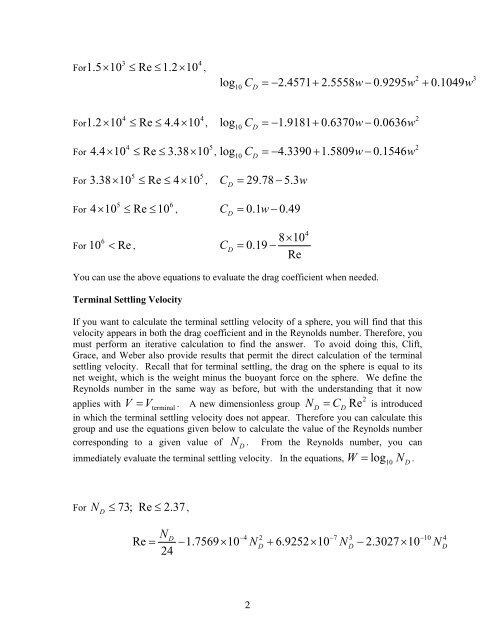Drag on a Sphere
Drag on a Sphere
Drag on a Sphere
You also want an ePaper? Increase the reach of your titles
YUMPU automatically turns print PDFs into web optimized ePapers that Google loves.
1.5× 10 ≤Re ≤ 1.2×103 4For ,log C =− 2.4571+ 2.5558w− 0.9295w+ 0.1049w10D2 31.2× 10 ≤Re ≤ 4.4×104 4For ,log C =− 1.9181+ 0.6370w−0.0636w10D24.4× 10 ≤Re ≤ 3.38×104 5For ,5 5× ≤ ≤ × CD= 29.78 − 5.33.38 10 Re 4 10For ,5 6× ≤ ≤ CD= 0.1w−0.494 10 Re 10For ,log C =− 4.3390 + 1.5809w−0.1546w10Dw2610 < ReFor ,C D8×10= 0.19 −Re4You can use the above equati<strong>on</strong>s to evaluate the drag coefficient when needed.Terminal Settling VelocityIf you want to calculate the terminal settling velocity of a sphere, you will find that thisvelocity appears in both the drag coefficient and in the Reynolds number. Therefore, youmust perform an iterative calculati<strong>on</strong> to find the answer. To avoid doing this, Clift,Grace, and Weber also provide results that permit the direct calculati<strong>on</strong> of the terminalsettling velocity. Recall that for terminal settling, the drag <strong>on</strong> the sphere is equal to itsnet weight, which is the weight minus the buoyant force <strong>on</strong> the sphere. We define theReynolds number in the same way as before, but with the understanding that it nowV = V terminalapplies with . A new dimensi<strong>on</strong>less groupD Dis introducedin which the terminal settling velocity does not appear. Therefore you can calculate thisgroup and use the equati<strong>on</strong>s given below to calculate the value of the Reynolds numbercorresp<strong>on</strong>ding to a given value of ND. From the Reynolds number, you canimmediately evaluate the terminal settling velocity. In the equati<strong>on</strong>s, W = log10ND.N= CRe2N ≤73; Re ≤2.37For ,DNDRe = − 1.7569× 10 N + 6.9252× 10 N − 2.3027× 10 N24−4 2 −7 3 −10 4D D D2
















